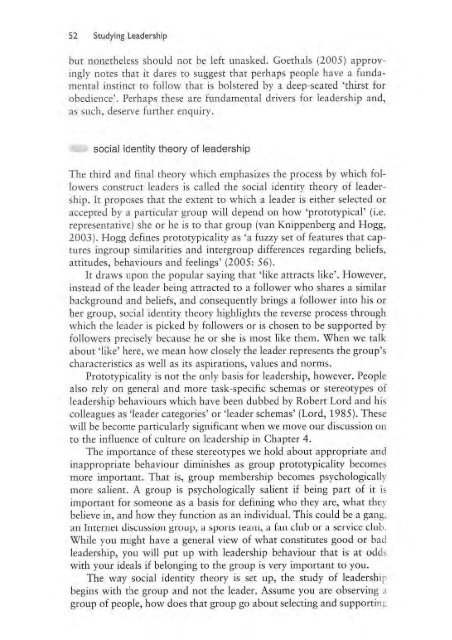Jackson Parry - Leadership, Chp 3, 41-60.pdf
Jackson Parry - Leadership, Chp 3, 41-60.pdf
Jackson Parry - Leadership, Chp 3, 41-60.pdf
- No tags were found...
You also want an ePaper? Increase the reach of your titles
YUMPU automatically turns print PDFs into web optimized ePapers that Google loves.
52 Studying <strong>Leadership</strong>but nonetheless should nor be left unasked. Goethals (2005) approvinglynotes that it dares to suggest that perhaps people have a fundamentalinstinct to follow that is bolstered by a deep-seated 'thirst forobedience'. Perhaps these are fundamental drivers for leadership and,as such, deserve further enquiry.social identity theory of leadershipThe third and final theory which emphasizes the process by \vhich followersconstruct leaders is called the social identity theory of leadership.it proposes that the extent to which a leader is either selected oraccepted by a particular group will depend on how 'prototypical' (i.e.representative) she or he is to that group (van Knippenberg and Hogg,2003). Hogg defiues proto typicality as 'a fuzzy set of features that capturesingroup similarities and intergroup differences regarding beliefs,attitudes, behaviours and feelings' (2005: 56).It draws upon the popular saying that 'like attracts like'. However,instead of the leader being attracted to a follower who shares a similarbackground and beliefs, and consequently brings a follower into his orher group, social identity theory highlighrs rhe reverse process throughwhich the leader is picked by followers or is chosen to be supported byfollowers precisely because he or she is most like them. When we talkabout 'like' here, we mean how closely the leader represents the group'scharacteristics as well as its aspirations, values and norms.Prototypicality is not the only basis for leadership, however. Peoplealso rely on general and more task-specific schemas or stereotypes ofleadership behaviours which have been dubbed by Robert Lord and hiscolleagues as 'leader categories' or 'leader schemas' (Lord, 1985). These\-vill be become particularly significant when we move our discussion onto the influence of culture on leadership in Chapter 4.The importance of these stereotypes we hold about appropriate andinappropriate behaviour diminishes as group prototypicality becomesmorc important. That is, group membership becomes psychologicallymore salient. A group is psychologically salient if being part of it isimportant for someone as a basis for defining who they are, what theybelieve in, and how they function as an individual. This could be a gang.an Imefllet discussioll group, a spons [cam, a [an club or a service club.While you might have a general view of what constitutes good or badleadership, you will put up with leadership behaviour that is at oddswith your ideals if belonging to the group is very important to you.The way social identity theory is set up, the study of leadersh ipbegins with the group and not the leader. Assume you are observing agroup of people, how does that group go about selecting and supportin.l'
















